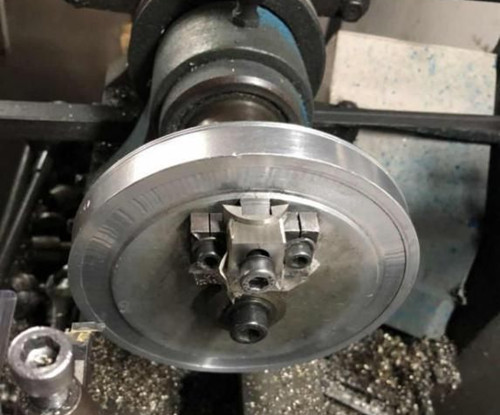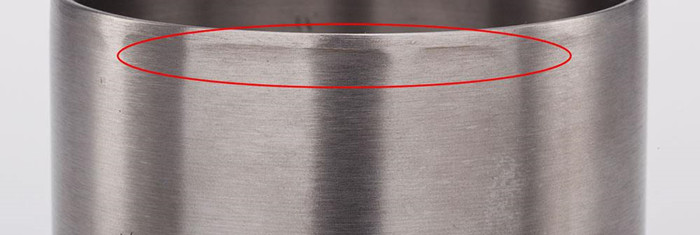Titanium and its alloy polishing methods
Titanium and its alloy have low density and excellent strength and weight ratio, good corrosion resistance and high mechanical strength, but expensive production cost. Titanium and titanium alloy grinding and polishing’s low efficiency make its microscopic structure change because the excessive severe cutting and polishing process will create a mechanical twin in the alpha phase.
At present, the methods of free abrasive grinding and chemical mechanical polishing are mainly used in the precision machining of titanium alloys. Grinding fluid is made by free silicon carbide or alumina abrasives, polishing fluid is a mainly strong acid, strong alkali or toxic chemical reagents, the free abrasives are difficult to control its movement trajectory, easy to leave deep scratches on the surface of the processing, reducing the processing accuracy. The handling of strong acids, strong bases and toxic chemicals is cumbersome, time-consuming and potentially hazardous to operators and the environment.
Early mechanical polishing processes were time-consuming, and almost all mechanical polishing methods used a polishing fluid containing an erosive agent in the final or two-step process. The electrolytic polishing methods can often get a better polishing surface, but the electrolyte brings a certain risk. This article here discusses the methods of grinding and chemical mechanical polishing to achieve super precision polishing of titanium alloys.

In the 1970s and 1980s, engineers Springer and Ahmed first published a paper on the polishing method of titanium and titanium alloys in 1984. This is the three-step sample polishing method. It is assumed that 320 grit paper is used to finish the sample grinding process, but this may not always be the case. If the sample is cut with an ultra-thin cutting piece or a grinding wheel cutting piece with appropriate bonding strength, the cutting surface is smooth and the damaged layer is minimal, 320grit is the ideal choice. If the cut surface is rough and the damaged layer is large, for example, if a band saw is used, then rougher sandpaper must be used and a certain amount of time must be spent to remove the damaged layer.
Springer, Ahmed titanium 3-steps polishing methods

- Grind, water cool with 320grit paper, grind for 2-3 minutes, remove the damage layer caused by cutting and make the surface of the sample flat. 320grit SiC sandpaper, water-cooled, rotate at 240 RPM, turn in the same direction, pressure: 27N (6lbs)/each sample until the sample is smooth. Note: removal of cut damage layer is the foundation of polishing, incomplete removal can directly affect the experimental results.
- Rough polishing, pre-apply 9 mm METADI® diamond polishing paste on TEXMET® polishing cloth with holes, use distilled water as cooling lubricant, and polish for 10~15 minutes. Rough polishing process: 9 mm METADI diamond polishing fluid + METADI polishing lubricant, polishing surface with ultra-pad ™, 120 RPM, reverse rotation, pressure: 27N (6lbs)/each sample, time: 10min.
- Finish polishing, using MICROCLOTH® or MASTERTEX® polishing cloth, adding MASTERMET® silica suspension polishing fluid and polishing for 10-15 minutes. Final polishing process: on the polished surface of MICROCLOTH, use MASTERMET silica polishing fluid, rotate at 120 RPM, reverse rotate, pressure: 27N (6lbs)/sample, time: 10min.
Müller titanium 3-steps polishing methods
- P500 sandpaper, water-cooled, rotating speed 300 RPM, pressure 16.7n (3.75lb) on each sample, preparation time until all samples are smooth.
- P1200 sandpaper was water-cooled at a speed of 300 RPM, a pressure of 16.7n (3.75lb) on each sample, and a 30S preparation time. Note: the specific time is determined according to the actual polishing situation, and the time parameters are only for reference. Usually, manual polishing is used for polishing, so the parameters may vary depending on the equipment.
- Synthetic non-pile polishing cloth + silica suspension polishing fluid containing chemical etchant, polishing machine speed is 150 RPM, polishing time: pressure on each sample is 33N (7.5lb) for 10 minutes, pressure on each sample is 16.7n (3.75lb) for 2 minutes, and pressure on each sample is 8N (2lb) for 1 minute.
- Polishing agent: 260ml SiO2+40ml H2O2 (concentration 30%),1mlHNO3 + 0.5ml HF.The P500 and P1200 grit sizes of FEPA correspond to ANSI/CAMI 320/360 and 600 grit, respectively.


